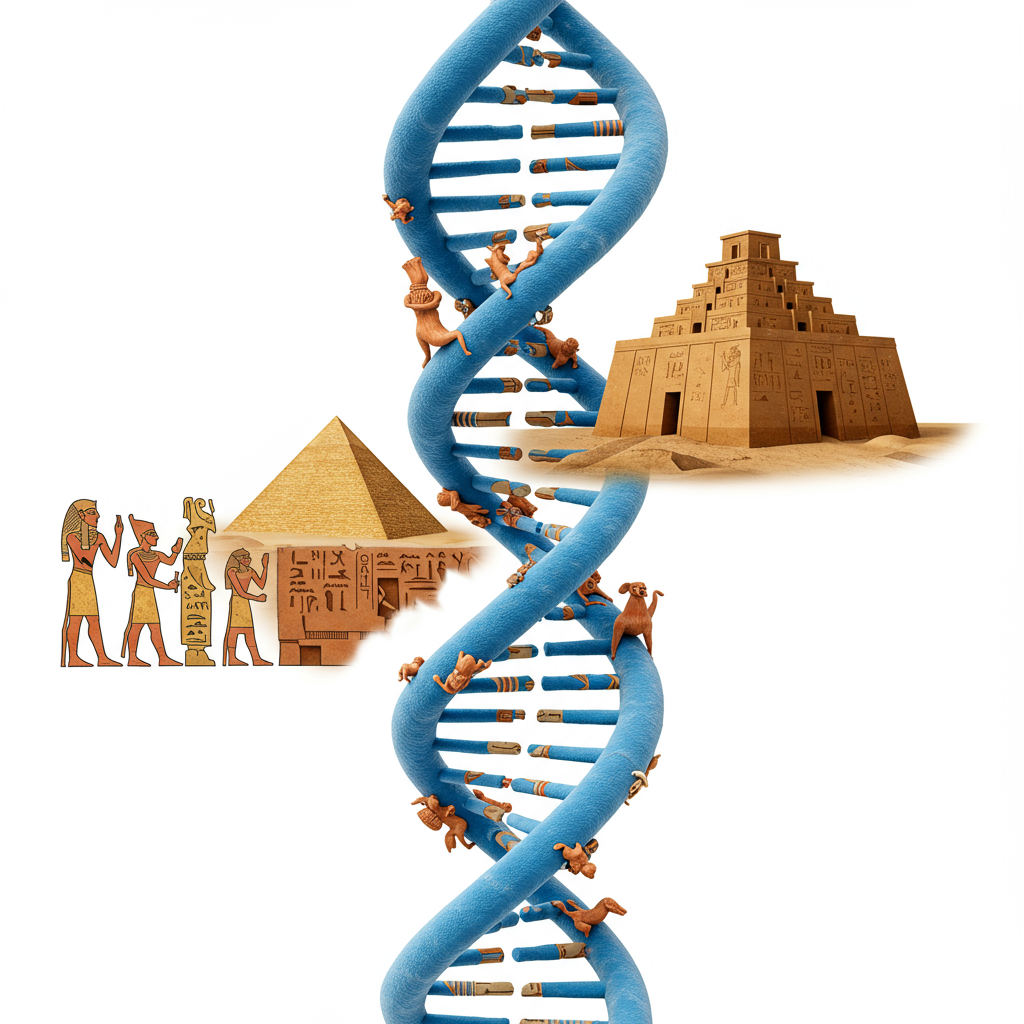A groundbreaking discovery, published in the journal Nature, provides the first direct genetic evidence of a significant connection between ancient Egypt and Mesopotamia. This finding moves beyond previous archaeological hints, offering biological proof that people moved and interacted between these two cradles of civilization thousands of years ago. Analyzing DNA from a remarkably well-preserved individual challenges previous assumptions and deepens our understanding of early human migration and cultural exchange across the ancient Near East.
For centuries, historians and archaeologists have speculated about the extent of interaction between the sophisticated societies along the Nile and those flourishing in the Fertile Crescent between the Tigris and Euphrates rivers. While evidence like trade goods, similar pottery styles, and parallels in early writing systems suggested contact, concrete proof of genetic ties remained elusive until now. This new study delivers that definitive biological link, confirming that the flow of ideas and goods was accompanied by the movement of people.
Unearthing the Genetic Link
The pivotal evidence came from sequencing the whole genome of a single individual. This wasn’t just any burial; the remains were found in a sealed funeral pot. This provided exceptional preservation conditions. The discovery occurred within an Egyptian tomb complex at the archaeological site of Nuwayrat. Scientists dated the remains to between 4,495 and 4,880 years ago. This places the individual’s life span at a crucial juncture in ancient history.
The genetic analysis yielded surprising results. While the majority of the individual’s genetic makeup, specifically four-fifths of the genome, showed expected links to North Africa and the region immediately surrounding Egypt, a substantial portion told a different story. A full fifth of the genome indicated ancestry connected to the area known as the Fertile Crescent. This is precisely where the great Mesopotamian civilizations, like Sumer, were simultaneously developing.
Why is This Discovery So Significant?
Experts universally agree on the profound importance of this genetic finding. Daniel Antoine, Curator of Egypt and Sudan at the British Museum, described the discovery as “highly significant.” He emphasized that it represents the “first direct evidence” supporting a connection previously only theorized or suggested by indirect archaeological clues. Earlier findings like shared pottery techniques or resemblances in early pictorial writing systems were compelling but didn’t conclusively prove the movement of people themselves.
Even suggestive resemblances found in ancient dental structures had hinted at possible ancestral links. However, these paled in comparison to the clarity provided by whole-genome sequencing. The DNA analysis provides a robust, biological confirmation of actual genetic mixing between populations. This level of detail was previously unattainable, relying instead on interpretations of material culture or physical anthropology that could be ambiguous.
The study offers compelling support for the idea that major geographical features weren’t just barriers. They could also act as facilitators of connection. Antoine speculated that the Nile River itself likely served as an “ancient superhighway.” This river wouldn’t just have been crucial for internal Egyptian transport and agriculture. It also potentially facilitated the movement of culture, ideas, and, critically, people, perhaps connecting inland African routes to coastal or overland routes towards the Near East.
A Life at a Crossroads of History
Analyzing the skeleton itself provided crucial insights into the individual whose genes unlocked this ancient secret. Bioarchaeologist Joel Irish of Liverpool John Moores University, a co-author of the study, examined the physical remains. Wear patterns on the bones offered clues about daily life. The presence of arthritis in specific joints suggested the man was likely in his 60s at the time of his death.
Interestingly, the pattern of wear and joint degeneration led researchers to believe the man may have worked as a potter. This potential occupation adds a fascinating layer to the genetic findings. Pottery-making techniques were among the very cultural elements previously noted by archaeologists as showing similarities between Egypt and Mesopotamia. It’s compelling, though speculative, to think that an individual with genetic roots in both regions might have practiced a craft shared by both cultures.
Living in a Time of Transformation
The era in which this individual lived was a period of monumental change. His lifespan falls just before or right at the dawn of ancient Egypt’s Old Kingdom. This was the period following the unification of Upper and Lower Egypt into a single, centralized state. This unification brought about unprecedented political stability. It ushered in an era of significant cultural innovation and state-sponsored projects. This golden age is perhaps best known for the construction of the iconic Giza pyramids, symbols of the power and organization of the newly unified kingdom.
As co-author Linus Girdland-Flink, a paleogeneticist at the University of Aberdeen, noted, this was precisely the time when centralized power consolidated. This process allowed the formation of ancient Egypt into the structured, powerful state we recognize from its most famous monuments. This political and cultural transformation was reshaping the Nile Valley.
Simultaneously, thousands of years ago across the sands, equally momentous developments were unfolding in Mesopotamia. Around the same time, the first Sumerian city-states were taking root. These independent urban centers in the Fertile Crescent were pioneering complex social structures. It was also during this period that cuneiform, one of the world’s earliest known writing systems, began to emerge and spread. This context highlights that the individual lived during a global (by ancient standards) age of burgeoning complexity and interaction between major centers of civilization.
The Path Ahead: More Ancient DNA Needed
While this study provides compelling direct evidence of genetic exchange, it is based on a single genome from one location and time period. The researchers themselves emphasize that this is just the beginning. Analyzing more ancient DNA samples from different sites across Egypt and Mesopotamia, and from various time points, is crucial.
Further research is needed to paint a clearer, more comprehensive picture. This future work could help determine the full extent of movements between these two cultural centers. It could also shed light on the frequency and timing of these interactions. Were they sporadic events, or part of sustained, regular contact? Did migration patterns change over time? More data will allow scientists to build more detailed models of ancient population dynamics and fully understand the tapestry of human connection in the ancient world.
Frequently Asked Questions
What did the ancient DNA study reveal about Egypt and Mesopotamia?
The study revealed a direct genetic link between ancient populations in Egypt and Mesopotamia. By sequencing the whole genome of a 4,500-year-old individual found in Egypt, researchers discovered that while most of his ancestry was local to North Africa/Egypt (four-fifths), a significant portion (one-fifth) traced back to the Fertile Crescent region of Mesopotamia. This provides the first biological proof of ancient connections, supporting previous archaeological hints.
Where was the ancient skeleton found for this DNA study?
The ancient skeleton analyzed in the study was discovered in an Egyptian tomb complex. Specifically, it was located at the archaeological site known as Nuwayrat. The remains were exceptionally well-preserved because they were found sealed within a funeral pot inside a chamber carved into a rocky hillside. This specific find enabled the high-quality DNA sequencing necessary for the groundbreaking genetic analysis.
How does this genetic evidence compare to earlier findings about Egypt and Mesopotamia?
Prior to this ancient DNA study, evidence of connections between Egypt and Mesopotamia was primarily based on archaeology. This included similarities in pottery styles, trade goods exchanged between the regions, and resemblances in early writing systems. While these suggested interaction, they didn’t prove direct population movement or genetic mixing. The new DNA evidence is significant because it offers the first direct, biological proof of genetic ties, confirming that people themselves were moving between these civilizations thousands of years ago.
Conclusion
This groundbreaking study, leveraging the power of ancient DNA analysis, offers a compelling new perspective on the interconnectedness of the ancient world. By uncovering a direct genetic link between ancient Egypt and Mesopotamia, it provides biological validation for decades of archaeological speculation about cultural exchange and interaction. The individual from Nuwayrat, living at the dawn of Egypt’s Old Kingdom and contemporaneous with the rise of Sumer, stands as a tangible biological bridge between two of history’s most influential civilizations. As researchers continue to explore the vast genetic archives preserved in ancient remains, we can anticipate even deeper insights into the complex movements and relationships that shaped early human history across the globe.




